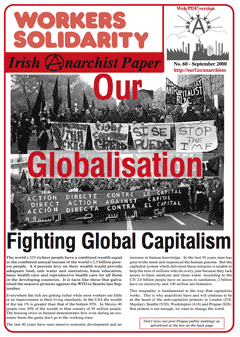Over 30 years of anarchist writing from Ireland listed under hundreds of topics
Beyond the 'Days of action against global capital' summit protests
Amsterdam, Geneva, Cologne, Seattle, London, Washington, LA, Prague. What do these cities have in common? In the last four years they have been the site of a new phenomenon, the Global Protest. For decades, the organisations that manage capitalism have met to divvy up the world among themselves. For the first time, their role as dealers of poverty and misery has been exposed by thousands of angry protesters. The symbolic value of these protests cannot be under estimated. If only for a brief period of time, a few days here and there, people have come together to say 'Enough!'.
Already however, the nature of these demonstrations has changed. Consider the difference between these protests.
Seattle: Thousands of protesters converge on the city. Despite using tear gas and implementing a curfew, the police lose control. The WTO summit is effectively blockaded. The demonstration is broadcast throughout the world media.
Philadelphia: Police arrest 'key activists' off the streets and at gathering centers before the demonstrations start. Bail is set so high that they are not released until after the protests, in two cases at 1 million dollars!
LA: From the start protesters are surrounded by the police. Police helicopters keep media choppers away. Alternative news sources are shut down.
The protests to date have been enormously successful. The difficulty in organising such events should not be underestimated. In the last few years networks have been built between people and organisations that span national border. The ability of the alternative media to cover such events, usually through the use of the internet is impressive. Activists have learned new skills and grown in confidence.
However it also seems that these demonstrations are becoming more limited in what they can achieve. As the police wise up to what is happening, more and more the protesters are faced with battling the state on its own turf. Seattle succeeded because surprise was on our side. Unfortunately, we cannot repeat that success. It is time to move the battle on. The Global Protests woke people up, it got them listening. Now we need to organise for the next stage.
The key word in the last sentence is organise. The global protests were organised by loose coalitions of people, united in their opposition to globalisation, though differing as to what should be put in its place. If they are to go further, instead of protesting against what exists, we must also be fighting for what could be better.
Unfortunately there is no formula to tell us what the next step is. Fortunately however there is a device that will help us on our way. This device is the anarchist method of organisation. New tactics emerge from the organisation's experience of activity, as it analyses and discusses what has happened, as it considers what can be tried next. Like the days of activity, the anarchist organisation is a means to an end. The aim of the global protests is not to overthrow capitalism. Yet clearly capitalism must be overthrown. They represent the first step, protest against the present. The next step is organisation for the future.
This article is from Workers Solidarity 60 - September 2000

Download the PDF file of WS 60

